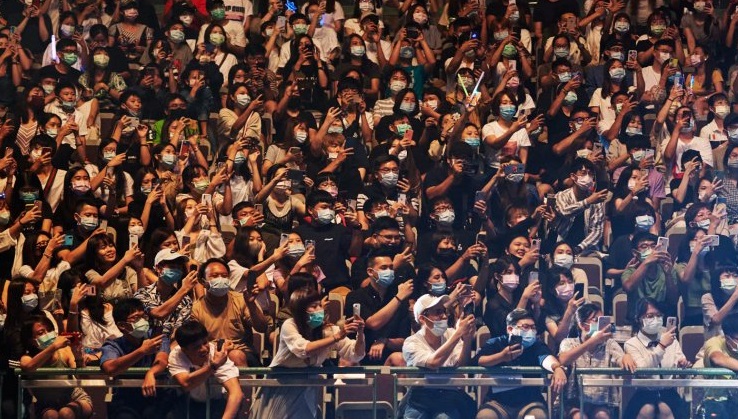Features
Asia’s Media & Entertainment Heading for V shape Recovery?

Over the past year, the entertainment sector has been one of the worst-hit industries globally, with live concert and movie box-office sales collapsing as theatres shuttered in the wake of nationwide lockdowns and coronavirus containment measures.
However, in a number of Asia-Pacific markets like Japan, China, Taiwan and Australia, where outbreaks have been controlled and infection levels have fallen significantly, theatre-goers have been returning, some in droves.
Although the global box office shrunk 70% in 2020 to US$12.4 billion, Asia-Pacific accounted for 51% of the total, according to data from Comscore and Gower Street Analytics. Since August, when majority of theatres re-opened around the world, Asia Pacific has accounted for nearly 78% of total box-office receipts worldwide.
Helping to drive a recovery in the region’s entertainment industry were competent outbreak control measures instituted by various governments, which included contact tracing, mask-wearing, and social distancing. Confidence among movie buffs has also grown as many countries began rolling out coronavirus vaccinations.
Last November, Goldman Sachs predicted a V-shaped rebound for the global economy on the back of Joe Biden’s projected US presidential election win and the rollout of Pfizer-BioNTech’s coronavirus vaccine. Since then, expectations of V-shaped recoveries for other economies – including Singapore, Malaysia, India and China – have increased. In fact, China became the only major economy globally to grow in 2020 – expanding by 2.3% according to official data – despite impact from the pandemic.

Asian Titles Score
Another key factor boosting the regional entertainment scene was the dearth of Hollywood blockbusters, coupled with a steady stream of local film releases, which allowed mostly Asian titles to score in the top 10 list.
Audiences rushed out to catch “Train to Busan: Peninsula”, the sequel to the hit South Korean zombie film “Train to Busan (2016)”, the first major release to premiere when cinemas reopened. It grossed S$2.9 million and was the second biggest movie in Singapore last year.
Local film-maker Jack Neo’s “The Diam Diam Era” and the Donnie Yen comedy “Enter the Fat Dragon” were the other Asian titles on the list, both grossing more than S$1.5 million in the city-state.
Meanwhile, last year, Japan’s box office also set a new record – an animated film based on a popular manga called “Demon Slayer” became the highest-grossing film in the country’s history. Likewise, Imax Corp reported it had achieved record attendance over New Year’s Day weekend in Japan.
As for China, total box-office revenues hit RMB20.4 billion (US$3.1 billion) in 2020, making it the world’s largest movie market for the first time, despite challenges from the coronavirus pandemic, according to data from ticketing platform Maoyan Entertainment.
By December, as the domestic COVID-19 outbreak was brought under control, the Chinese film market had recovered to an overall level of 90% year-on-year, with the monthly box-office tally reaching 92%, compared to the same period in 2019.
Historical war dramas, including “The Eight Hundred” and “The Sacrifice”, made significant contributions to the country’s movie market recovery in 2020, grossing RMB4.2 billion in the box office.
For Taiwan, which has reported low or non-existent COVID-19 cases since April, low domestic infection rates have helped a string of local hits achieve robust box-office performances. Among the top-grossing titles were LGBTQ drama “Your Name Engraved Herein”, college romance “Do You Love Me As I Love You”, and horror movie “Rope Curse 2”.

Never Out of Style
While video streaming services like Netflix have benefited as the pandemic forced more people to stay home, studios still prefer to open a blockbuster at a movie theatre – which is a far more lucrative option – rather than releasing it to streaming and on-demand platforms.
As a result, most big-budget, high-profile production titles – ranging from James Bond’s “No Time to Die” to Marvel’s “Black Widow” and “Ghostbusters: Afterlife” – have delayed their release dates, with most adopting a wait-and-see attitude till more movie theatres re-open their doors.
And if history is anything to go by, the cinema industry, which has shown its remarkable resilience in the face of past pandemics, is unlikely to go out of style.
From 1918 to 1920, when the “Spanish Flu” took the lives of 50 million people worldwide at the end of World War One, cinemas shuttered around the globe. Likewise, in the US, the closure of cinemas due to flu epidemics has occurred on a regional basis. And on each and every occasion, although the cinema industry was impacted, it managed to survive – and flourish even – because it was able to adapt to changing dynamics. This time will be no different, and the magic of the big screen will reassert itself, analysts contend.
Box-office takings aside, revenues in the global live music scene are also expected to stage a similar recovery this year. Auditing firm PricewaterhouseCoopers (PwC)’s Global Entertainment & Media Outlook 2020–2024 report forecasts that live music will rebound in 2021, with worldwide revenues growing by 82.6% to over US$19 billion as concerts resume.
Singapore, for example, plans to pilot small-scale, live performances that will serve as trials for the live events industry’s progressive resumption on a broader scale, its Ministry of Culture, Community and Youth (MCCY) said in August.

Commitment to Culture
Recognising the important role that movies, concerts and the arts play in the mental well-being of citizens, governments around the world are extending a helping hand to ensure the industry weathers the unprecedented effects of the pandemic.
Last December, US Congress passed a US$900 billion coronavirus relief package, which includes US$15 billion to help the nation’s culture sector. Similarly, Germany has announced that it will increase its culture and media budget by more than 120 million euros in 2021, boosting the culture ministry’s total budget to 1.9 billion euros, underscoring the country’s commitment to its culture industry.
At home, in Singapore’s Resilience Budget, the government designated S$55 million for the arts and cultural sector. This is in addition to the S$1.6 million that was set aside earlier for two initiatives – a capability development grant and a subsidy scheme to reduce rental and associated costs.
And with the global movie and live events industry poised on the cusp of a rebound, with theatres in some countries already showing signs of robust recovery, investor interest in entertainment plays has resurfaced.
American global entertainment company Live Nation Entertainment Inc’s (NYSE: LYV) share price performance is a case in point. The stock has gained about 47% to US$72.28 currently from its 1 January 2019 level, more than tripling from its 52-week low of US$21.70.
Likewise, shares of American movie theatre chain Cinemark Holdings Inc (NYSE: CNK) have more than tripled to US$19.56 from their 52-week low of US$5.71, while Filipino media and entertainment group ABS-CBN Corporation’s (PSE: ABS) stock has more than doubled to 13.96 pesos from its 52-week low of 6.66 pesos. Shares of AMC Entertainment Holdings (NYSE: AMC), the world’s largest cinema chain operator, also soared more than 30% after announcing it has raised funding to help it tide through the coronavirus-impacted winter.

Resurgent Investor Interest
In Singapore, while the operating environment remains challenging due to COVID-19 restrictions, bargain-hunting of a few local entertainment stocks has begun, with most of the negatives already priced in. SGX-listed events and concerts producer and promoter, UnUsUaL Ltd (SGX: 1D1), also saw its share price recover by more than 80% from the peak of the coronavirus crisis, while Vividthree Holdings Ltd (SGX: OMK), Singapore’s first listed immersive digital content production powerhouse, also saw its share price surge more than 50% from its 52-week low to 5.5 cents.
The strong interest in the entertainment sector was also evident in new entertainment and media listings, which drew huge investor inflows. This was obvious from the initial public offer (IPO) of Special Purpose Acquisition Company (SPAC), Vistas Media Acquisition Company (VMAC), on Nasdaq last August. Led by CEO F. Jacob Cherian as well as Singapore non-resident Indian (NRI) media entrepreneurs and co-founders, the SPAC hopes to acquire media and entertainment businesses globally.
Last October, Big Hit Entertainment (KRX: A352820), the management label of popular South Korean boy band BTS, doubled its IPO price on its trading debut. It opened at 270,000 won, compared with the offer price of 135,000 won, which was already at the top end of the IPO’s indicative price range.
Institutional investors sought more than 1,000 times the number of Big Hit shares on offer, while South Korean retail investors placed 58.4 trillion won in orders for the retail portion, making it the biggest South Korean IPO since Celltrion Healthcare raised one trillion won in 2017.
BTS accounted for nearly 90% of Big Hit’s revenues in the first half of 2020, according to data from a regulatory filing. The seven-member band has become the first South Korean group to reach No. 1 on the US Billboard Hot 100 singles chart with their song “Dynamite”.
Last December, entertainment and content provider GHY Culture & Media Holdings Ltd (SGX: XJB) made its debut on the Mainboard of Singapore Exchange (SGX) at 70 Singapore cents per share, more than 6% above its IPO price of 66 cents per share. The public tranche of the IPO was 16 times subscribed, while the placement was about 8.6 times subscribed. GHY shares have since appreciated more than 20% from its IPO price to 81 cents per share.
Even with investors bottom-fishing oversold stocks in the local entertainment sector, laggards still exist, due to the overhang of company-specific concerns. While mm2 Asia Ltd (SGX: 1B0), one of the region’s entertainment conglomerates, has rebounded nearly 30% from its 52-week low, its price performance has still lagged peers on worries over the Group’s high gearing. Nonetheless, investor optimism may return on the back of various strategies unveiled by mm2 to pare down its huge financial debt obligations, which has weighed on the stock. These strategies include the planned spin-off and listing of its cinema assets on SGX, as well as the proposed merger of its cinema assets with Golden Village Cinemas in Singapore which are slowly unveiling.
It does seem that the proverbial “Lights”, “Cameras” are ready, will the “Action” that follows to be an explosive V shape which seems to be on the card?
Readapted by AsiaOne
By GEM COMM Writer




